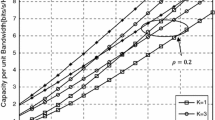Abstract
In this paper, delay constrained performance of a multiple-input multiple-output (MIMO) communication system in a dense environment with co-channel interference is investigated. We apply orthogonal space-time block coding (OSTBC) at the transmitter, and for alleviating the high complexity and cost of the MIMO system, receive antenna selection (RAS) scheme is employed in the downlink. Here, for simple and cheap mobile handsets, one antenna is chosen at the receiver in each utilization of the channel. Under these assumptions, a maximum constant arrival rate with the delay quality-of-service guarantee in a wireless channel is extracted. We obtain a closed-form solution for the effective capacity of the MIMO–OSTBC channel with the RAS scheme in a quasi-static Rayleigh fading conditions and co-channel interference. After all, the numerical simulations are provided and verified the theoretical results.








Similar content being viewed by others
References
Su, G. M., Su, X., Bai, Y., Wang, M., Vasilakos, A. V., & Wang, H. (2015). QoE in video streaming over wireless networks: Prespectives and research challenges. Wireless Network. New York: Springer. doi:10.1007/s11276-015-1028-7
Niu, Y., et al. (2015). Exploiting device-to-device communications in joint scheduling of access and backhaul for mmWave small cells. IEEE Journal on Selected Areas in Communications, 33(10), 2052–2069.
Wu, D., & Negi, R. (2003). Effective capacity: A wireless link model for support of quality of service. IEEE Transaction on Wireless Communications, 2(4), 630–643.
Soret, B., Torres, C. A., & Entrambasaguas, J. T. (2010). Capacity with explicit delay guarantees for generic source over correlated Rayleigh channel. IEEE Transaction on Wireless Communications, 9(6), 1901–1911.
Tang, J., & Zhang, X. (2007). Quality-of-service driven power and rate adaptation over wireless links. IEEE Transaction on Wireless Communications, 6(8), 3058–3068.
Tang, J., & Zhang, X. (2007). Quality-of-service driven power and rate adaptation for multichannel communications over wireless links. IEEE Transaction on Wireless Communications, 6(12), 4349–4360.
Lari, M., Mohammadi, A., Abdipour, A., & Lee, I. (2013). Characterization of effective capacity in antenna selection MIMO systems. Journal Communications and Networks, 15(5), 476–485.
Lari, M., Mohammadi, A., Abdipour, A., & Lee, I. (2012). Effective capacity in receive antenna selection and spatially correlated MIMO–OSTBC systems. In 6th International symposium telecommunications, (IST’12), Tehran, Iran, pp. 117–122.
Lari, M., Mohammadi, A., Abdipour, A., & Lee, I. (2012). Characterization of effective capacity in AF relay systems. IEICE Electronics Express, 9(7), 679–684.
Musavian, L., Aissa, S., & Lambotharan, S. (2010). Effective capacity for interference and delay constrained cognitive radio relay channels. IEEE Transactions on Wireless Communications, 9(3), 1054–1062.
Perez, D. L., et al. (2013). On distributed and coordinated resource allocation for interference mitigation in self-organizing LTE networks. IEEE/ACM Transactions Network, 21(4), 1145–1158.
Perez, D. L., et al. (2014). Power minimization based resource allocation for interference mitigation in OFDMA femtocell networks. IEEE Journal on Selected Areas in Communications, 32(2), 333–344.
Zhang, Z., et al. (2015). Full duplex techniques for 5G networks: Self-interference cancellation, protocol design, and relay selection. IEEE Communications Magazine, 53(5), 2–10.
Rini, S., & Goldsmith, A. (2014). On the capacity of the multiantenna Gaussian cognitive interference channel. IEEE Journal on Selected Areas in Communications, 32(11), 2252–2267.
Youssef, M., et al. (2013). Routing metrics of cognitive radio networks: A survey. IEEE Communications Surveys and Tutorials, 16(1), 92–109.
Lari, M., Bassam, S. A., Mohammadi, A., & Ghannouchi, F. M. (2011). Time-multiplexed single front-end multiple-input multiple-output receivers with preserved diversity gain. IET Communications, 5(6), 789–796.
Shin, H., & Lee, J. H. (2004). Performance analysis of space time block codes over keyhole Nakagami-m fading channels. IEEE Transactions on Vehicular Technology, 53(2), 351–362.
Yao, Y., Zheng, J., & Feng, Z. (2012). Small-scale variations of cross-polar discrimination in Nakagami-m fading channels. IEEE Communications Letters, 16(11), 1820–1823.
Gradshteyn, I. S., & Ryzhik, I. M. (2007). Table of Integrals, Series, and Products (7th ed.). New York: Academic Press.
Chang, C. S., & Thomas, J. A. (1995). Effective bandwidth in high-speed digital networks. IEEE Journal on Selected Areas in Communications, 13(6), 1091–1100.
Catreux, S., Driessen, P. F., & Greenstein, L. J. (2000). Simulation results for an interference-limited multiple-input multiple-output cellular system. IEEE Communications Letter, 4(11), 334–336.
David, H. A. (1981). OrderStatistics (2nd ed.). New York: Wiley.
Author information
Authors and Affiliations
Corresponding author
Rights and permissions
About this article
Cite this article
Lari, M. Effective capacity of receive antenna selection MIMO–OSTBC systems in co-channel interference. Wireless Netw 23, 1223–1231 (2017). https://doi.org/10.1007/s11276-016-1219-x
Published:
Issue Date:
DOI: https://doi.org/10.1007/s11276-016-1219-x




